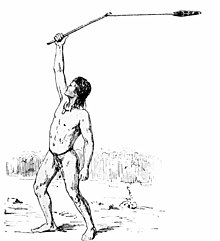Bororo

The Bororo are a macro- speaking indigenous people from the south of Mato Grosso , Brazil ; Parts of this people also lived in the Brazilian state of Goiás and in Bolivia . The language of the people belongs to the Macro-Ge language family.
The Bororo had their first contact with Europeans in the early 18th century . Johann Natterer , who traveled to Mato Grosso around 1825, described the Bororo da Campanha in a letter in 1826 as follows:
“They used to inhabit the steppes along Paraguay's right bank, from the R. Jauru to the Bahia da Uberaba [..] and, when they were still hostile, caused a lot of harm here and on the streets of Matogrosso, until they finally got to the Peace nodded [..] So far they have not disturbed the peace, they nomadize in small hordes on the local fazenda, some have settled in Pau secco 5 miles west of here. "
The ethnologist Karl von den Steinen dedicated a large part of his work Among the primitive peoples of Central Brazil to them. Travel descriptions and results of the Second Schingú Expedition 1887–1888 .
At the end of the 19th century, the army engineer Cândido Rondon met the Bororo; he managed to pacify them and to participate in the construction of a telegraph line to Bolivia and Peru .
The French ethnologist Claude Lévi-Strauss , who was mostly in Brazil between 1935 and 1939 and held a professorship in São Paulo from 1935 to 1937, visited Bororo in 1935 during a trip to the interior of Brazil in order to conduct field research with them. He examined settlement style, rites, clothing, singing, myths, body painting, dances, tools and language of the Bororo, which he named as the crown jewel for every ethnologist, since their social structures are complex and very complicated ( Sad Tropics , 1955 and Das Rohe und das Boochte , 1964).
In 1999 there were still around 750 Bororos in Brazil living in seven villages. This small number is mainly explained by assimilation with the immigrants, but also by murder , displacement ( e.g. during the construction of the Transamazônica ) and the introduction of diseases by the Europeans. The Bororo are known - like other Indians in this area - for their ornate feather headdresses, which they wear during ceremonies and ritual dances.
literature
- David Maybury-Lewis , Edward C Henderson: Dialectical Societies: The Ge and Bororo of Central Brazil , Harvard University Press, 2013
Web links
- Bororo. In: Povos Indígenas no Brasil , Instituto Socioambiental (Portuguese, English, Spanish)
